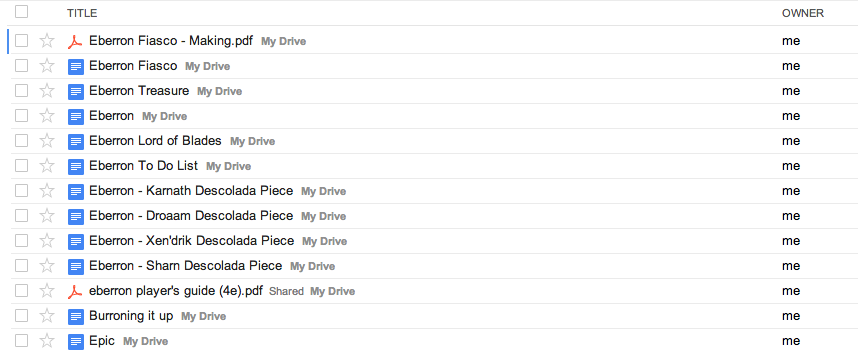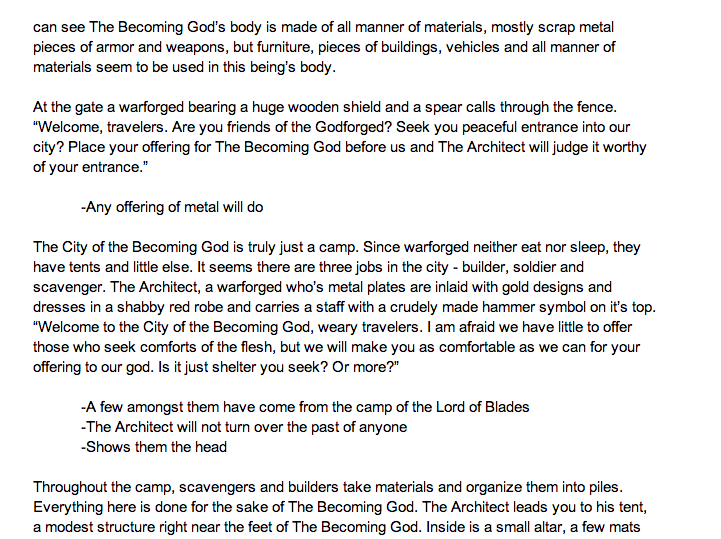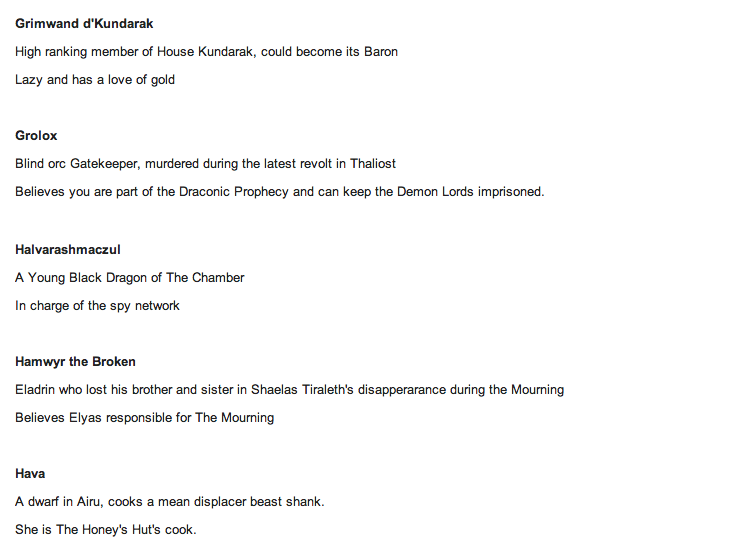The Google Master’s Binder
So I’m taking a little diversion this post from Exploration Age to talk about the theme of this month’s RPG Blog Carnival. That theme? GM binders.
Way, way, way back in the day when I was ten and playing The Fantasy Trip I used a marble composition notebook in which I wrote every whack campaign idea I had (many of which we’re never played). This included an entire campaign based off the James Bond movie The Man with the Golden Gun. The Man with the Golden Hand Crossbow (I was ten) was a rollicking tale and one of the first stories I ever ripped off completely. Here’s to you marble composition notebooks! May you hold young children’s campaigns, MASH games, dot-man wars, and secret crushes forever.

Google Drive
My gaming notes today are organized, but usually only in a way that would make sense to me. I’ll use my last campaign as an example. I ran a group of six PCs through a Fourth Edition Dungeons and Dragons Eberron game that lasted from levels one to thirty. The ideas for this campaign began where many today probably do – Google Drive.

Why Google Drive? Well there’s a few reasons. First I work on my game in a lot of different places. At home on my laptop, on my phone in the train headed to work, and on my work computer during my lunch hour. With Drive being a cloud I can work on my home laptop, my phone, and my work computer without having to lug too much back and forth. I can easily output word docs, tables, PDFs, etc. to share with my players or print stuff out and bring it to games. Plus, 15GB is plenty of space for campaign notes.
In Google Drive I kept a bunch of different documents related to the Eberron game, but they mostly fit into these categories.
-
Campaign Outline – A brief outline of where I think the campaign is going. This is so I can see how things are playing out, what the endgame might be, and what’s happening in the world beyond the scope of the party. I usually update thisdocument every few sessions. Here’s a look at my outline during ourepic tier of play (forgive any typos, remember, this was just for me).
-

Eberron is badass!
-
-
Open Threads – Then I also have a list of open threads (and believe me there were PLENTY in this campaign). Here’s where I list all of the unresolved issues in the campaign. Stories from side quests, character backgrounds, secret dealings, and consequences reverberating from the party’s actions all go here. I leave this open while we play and jot down notes quickly. Anything that gets resolved I highlight in red.
-

Seriously, this is just a PIECE.
-
-
Weekly Quest – This is where I kept detailed information about what would (might) happen during our weekly session. Monster stats, read aloud text, traps, NPC statistics, and general adventure information would go here. Here’s another taste.
-

Again, please forgive typos.
-
-
Treasure – If you’ve ever played 4th edition, you know that there’s many a magic item to give out. If a player doesn’t have the right magic items the math for attacks and defense won’t work out. In this case I awarded over 150 magic items (not counting consumables like potions). It’s a lot to track along with gold and monetary rewards so I had a separate document for that.
-

I’ll assume this only makes sense to 4e DMs, but here it is.
-
So those documents help me track what the campaign is doing and where it’s going, and a tiny bit what’s in the past. However most of the past of this campaign was tracked if a different way – via gmail.
Gmail
I’ve tried using Obsidian Portal before, but unfortunately for as much as I loved it, getting my players to use it made taking a dog to the vet seem easy. Obsidian Portal and services like it are awesome, but they’re a ton of work as well and if my players aren’t into it then it’s not worth the effort.
My players do read emails. Going to a website and navigating for the answers you want requires more effort than opening and reading an email. Likewise typing an email is a lot less work than managing an Obsidian Portal account. So after each session I’d send an email with the following information – a list of the known quests and tasks they had committed to completing, a brief summary of what happened during the previous session, a list of who was wounded or diseased, a list of rewards gained during the previous session, and an updated quest wiki.

Our wiki was simple and tacked onto each email. It was divided into three categories – people, places, and organizations. Each was organized with alphabetical entries that had no more than two lines of description. I’d simply copy and paste the wiki from the previous recap email then add to it for the current email. It started small and was enormous by the end, but it was a helpful reference for the players and myself. They didn’t have to read it each week, but they knew it was there for them when they needed it. Plus, it was super easy for me.

Roll20
I’ve already sung the praises of roll20.net, but this is where I kept all my maps for battle, which is super important in a Fourth Edition D&D game. I could archive maps I really loved and might use several times throughout the campaign (like the deck of the party’s airship or the temple which served as their home base).
If roll20 doesn’t turn you on, there’s a lot of other services like it. Recently I did a soon to be released podcast interview with Doug Davison of Fantasy Grounds. This product is badass and I highly recommend checking that out as well. The podcast will be released in two weeks, but until then check out their video.
The Future
Again, through my podcast, The Round Table, I recently learned about a new product for worldbuilding and campaign tracking called Realmworks. Right now this product is only available on PC, which stinks for us Mac users like me. However thanks to the podcast interview with Liz Theis (coming next week) I’ve learned Realmworks will one day be available through the web. When that day comes, I’ll be super excited to keep my GM notebook with that product. It’s full of tons of ways to make prep, worldbuilding, story-tracking, and on-the-fly note taking easy. Check out the video below to get more information about what Realmworks can do.
Until then, I’m working on outlining Exploration Age with, you guessed it, Google Drive!
A Postscript – Eberron Fiasco
Also, as a bonus in this blog post, I was going through my old notes and I found a Fiasco playset I created for Eberron. It was supposed to be used in the event I couldn’t make a session, but the players still wanted to play something. That never actually happened, but I think it a group could use this playset in a bunch of different ways. Maybe a way to kickoff a campaign or to create a story that somehow ties into an overall Eberron campaign. If you’re familiar with Eberron, the playset is meant to be set before The Mourning in the city of Making in the country of Cyre. Anyway, it’s super niche, but I thought I’d share since I never got to use it. So on the off-chance you love Eberron AND Fiasco, check it out in the link below. Let me know if you actually use it and how it goes! I’d love to know.
Eberron Fiasco – Making
Become a Patron!
If you like what you’re reading please consider supporting me on Patreon, supporting me on Ko-fi, follow me on Twitter, like World Builder Blog on Facebook, check out my podcasts, find my products on the DMs Guild, tell your friends about the blog, and/or leave me a comment and let me know you think. Thanks!
April 29, 2014 @ 8:58 am
I have used & love Obsidian Portal. However, I agree that many players don’t take the (very simple) step of going in to read it. I don’t even need the forums & back-and-forth… I just use it as a place to put adventure summaries & world info. However, as a writer, that means that the wikis are HUGE. Still, the players that do read it tend to be bard-type characters, or those who would care about the history of the world… so when I throw in a hint to something on the History page, they tend to at least remember reading *something* about it, which gives them a reason to make a History check or ask me to jog their memory, at which case I pull out the laptop so they can re-read whatever I wrote.
But for DM/GM planning, I’ve often kept separate documents as well. I recently switched over to a more Google Drive-centric setup, because my previous approach was to have all my Word files on a flash drive that I’d bring with me. Of course, inevitably, I’d be somewhere and realize I’d forgotten the flash drive, and then all my game planning time would be for naught. The cloudiness of Google Drive has fixed that (though, for layout purposes, I still tend to use Word for writing out the actual adventures… Drive just holds all my copious notes).
Reply
April 29, 2014 @ 5:52 pm
I know. How to get those players to add to OP is the key!
Reply
April 29, 2014 @ 1:48 pm
If you reeeeally wanted to run that windows program I hear this works: http://www.parallels.com/products/desktop/
I also keep to marbled notebooks. Less secrets nowadays, more grocery lists 😉
Reply
April 29, 2014 @ 1:50 pm
Hahahahaha! I do love parallels.
Reply
April 29, 2014 @ 5:23 pm
I tend to use Obsidian Portal and an old fashioned notebook mainly. I particularly like how I can hide information in Gm-only sections on Obsidian Portal. I typically keep all of my game notes in a blank Adventure log section in its GM-only section with links to NPCS (whose stats are similarly hidden from my players). It helps that my players do read the logs and even sometimes add to the site.
I still like old fashioned notebooks for brainstorming. I find it more versatile than current digital tools (so I can draw arrows, write sentences, and draw pictures all on one page). Though recently I’ve found workflowy handy as well.
Reply
April 29, 2014 @ 5:25 pm
True. Sometimes nothing beats a notebook! Good idea. Keep your notes in the GM only section and then make it public. Less work for you in updating Obsidian Portal!
Reply
April 29, 2014 @ 5:43 pm
My Google Drive looks a lot like yours, only perhaps less organised. haha.
But yeah, I keep campaign plans for future plots (whether they’re relevant to current party location or not), NPC info, combat encounter plan (sometimes down to what happens on what turn – depending on the actual event to how detailed I want it), maps for things (usually not tactical maps – just basics so I know what direction stuff is and basically how far distances are so I can build tactical maps quickly if needed).
For actual table game notes, to compare to your old notebook (which is awesome btw) I generally have a big ring binder folder – so I can refer to previous notes if I need to look up something (I try to avoid this sometimes by moving still-relevant item descriptions and NPC info from old session notes into current session notes prior to playing but you always get the odd question about something you didn’t expect). My biggest issue with the ring binder happens when it fills up – because then I have to pull everything out of it and decide on a point at which to ‘archive’ stuff, then transfer this oldest of material into another folder. And yes, I have several of these folders now, organised into volumes. 🙂
Reply
April 29, 2014 @ 5:51 pm
Hahahaha a less organized Drive but archived and organized binders? I could never keep track of physical notes like that. My hat to you, sir!
Reply
April 2014 Blog Carnival: The Game Master’s Binder – That’s a Wrap | of Dice and Dragons
May 3, 2014 @ 8:01 am
[…] at World Builder Blog James starts us on his journey, from the composition notebook. I remember using these for school […]
Reply
May 29, 2014 @ 7:22 pm
The official blog claims that his client has issued to date news and views, so you
get to see, choose and buy the latest range of traditional Indian fashion and footwear, jewelry, handbags,
clothing Indo western decor household, etc. Typically
quite a few dry cleaning places have sewers.
Mainstream media pretty much has the largest encompassing result to the way we dress.
Reply
June 2, 2014 @ 1:47 am
They might be the yelling fans or the silent admirers,
but in adopting that fashion trends, they feel to have belong to the same group.
To make a short neck look longer wear a scoop neck or open collar shirt, complete the look with
a long necklace. They rely on more 140 suppliers worldwide, with each region specializing in a certain type of clothing that it can manufacture at a competitive price.
Reply
Simple Sandboxes – World Builder Blog
January 25, 2018 @ 7:01 am
[…] it comes to sandboxes, a little bit of paperwork goes a long way. Open up your handy Google Doc (or whatever you take notes in) and write down the name of every published adventure or campaign […]
Reply